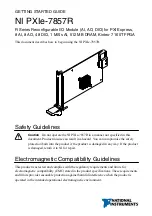
en – Original Instructions
14
Installation, Operation and Maintenance Manual
3.6
Intended use
Circulating pump for domestic hot water systems.
If hot water is not used for longer periods of time, the water in the hot water pipe cools off.
Domestic hot water pumps (also called sanitary or drinking water circulating pumps) pump this
cold water back into the water heater via a separate recirculation pipe, or directly into the cold
water supply line (see Figure 5 and Figure 6 on page 19 and 20). At the same time fresh hot
water is flowing out of the water heater and provides a constant supply of hot water at the tap.
WARNING: Risk of electric shock
This pump has not been investigated for use in swimming pool or marine areas.
Do not install within an outer enclosure or beneath the skirt of a hot tub or spa.
This pump is not submersible.
CAUTION:
Acceptable for indoor use only. This pump has been evaluated for use with water only. Use with
maximum 203 °F (95 °C) water.
Pump selection
The e
3
-4 series models are designed to handle the recirculation requirements of residences with
a pipe loop (the total length of hot water supply line plus the recirculation line) up to 250 ft (76 m).
The e
3
-6 series pumps are designed to handle the recirculation requirements of residences and
small apartment complexes with pipe loop runs to 700-1000 ft (213-305 m).
Because the system is pressurized, the number of floors in a home is not taken into consideration
in sizing the circulating pump. The pump has only to produce continuous flow at a pressure
sufficient to overcome the friction losses created by the piping in the house water supply line
and the return line.
NOTICE: Water pressure
A recirculating system is a pressurized system operating at the city water pressure, as
determined by the pressure regulator on your line, or by a well pump, if you are on a well system.
In most residential plumbing systems, water pressure is set at 35 psi (241 kPa) and above.
Below 35 psi (241 kPa), water pressure may not be sufficient to fill the pipe diameter, leaving
space for air to accumulate in the lines.
If your system pressure is less than 35 psi (241 kPa), use the next larger pump on the Pump
Selection Guide.
NOTICE: Oversized pumps
Pumps should not be so large as to produce flow rates that may eventually erode holes in the
pipes. According to the Copper Development Association, excessive erosion occurs at a velocity
of about 5 ft (1.5 m) per second and higher; or about 4 gpm (15 l/min) in 1/2" Type M copper
pipe.
Use the recommended recirculation line size shown in the Pump Selection Guide. The e
3
series
pumps are sized so that flow velocities are below these limits.
Autocirc pumps
In case using an Autocirc pump, there is no need to build a separate recirculation line, the unit
should be installed under the sink farthest from the water heater, where hot water takes longest
to arrive. The pump then moves the cool water in the hot water supply line into the cold water
supply line, ensuring instant availability of shower warm water with maximum temperature hot
water only seconds behind. When the pump is off, a built-in auto closure device prevents hot
and cold water mixing. Hot water will also be instantly available at all other faucets/taps between
the water heater and the sink under which the Autocirc pump is installed. See the operating
principle in Figure 4 on page 15.















































